Exploring Yamagata with a footbath bullet train: Toreiyu Tsubasa
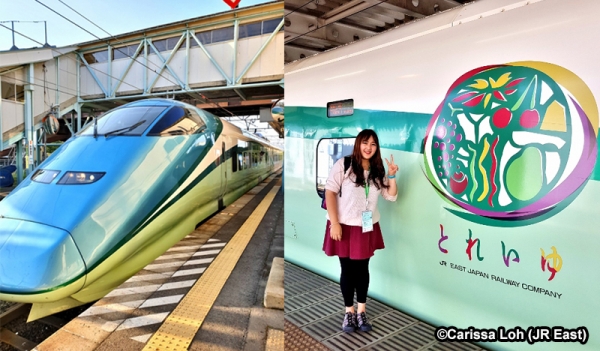
NOTE: The Toreiyu Tsubasa permanently ceased operations from March 2022.
As an onsen lover, one of my favourite Joyful Trains is the Toreiyu Tsubasa (とれいゆつばさ), a bullet train featuring footbaths (足湯 ashiyu), which are essentially onsen for the feet. Running on the Yamagata Shinkansen Line, this Joyful Train’s concept is to pay homage to Yamagata Prefecture (山形県 Yamagata-ken), which is famous for its charming onsen towns like Ginzan Onsen, Tendo Onsen, Kaminoyama Onsen, and more. With some planning, this fun and relaxing train can easily be part of your trip to Yamagata Prefecture. Let me show you how!

Toreiyu Tsubasa in different seasons. (Image credit: JR East)
Mention Japan and one of the first things that might pop into your mind is onsen (温泉 hot springs). Japanese people love visiting the onsen. Stemming from a culture of tōji (湯治 therapeutic bathing), where soaking in onsen for long periods of time was believed to cure ailments, nowadays taking a dip in the onsen is believed to provide many benefits such as healing a fatigued body or mind, relaxing muscles, and beautifying skin. Refurbished from an E3 series bullet train, the Toreiyu Tsubasa aims to fit this onsen experience onto a train, by having a footbath and lounge onboard! In addition, you can enjoy beautiful seasonal scenery from the window: from bright greens in summer, to golden yellows in autumn, to frost snow-covered fields in winter. The Toreiyu Tsubasa’s footbath is such a wonderful and relaxing experience that I highly recommend everyone to try out.

Colourful and comfortable interior of the Toreiyu Tsubasa. (Image credit: JR East / Carissa Loh)
Upon entering the train, one of the first things you will notice are its striking, vibrant red reserved tatami mat seating. The recently redesigned blue cushions feature illustrations of Yamagata motifs such as shōgi (将棋 Japanese chess) pieces, cherries (Yamagata’s most famous fruit produce), and Hanagasa Festival hats (the Yamagata Hanagasa Festival is Yamagata’s most well-known summer festival). These tatami seats are also very comfortable to sit on, and the train has lots of space for storing luggage. So if you are going to be travelling on the Yamagata Shinkansen Line, why ride a regular bullet train when you can ride this?
Enjoy a footbath on board
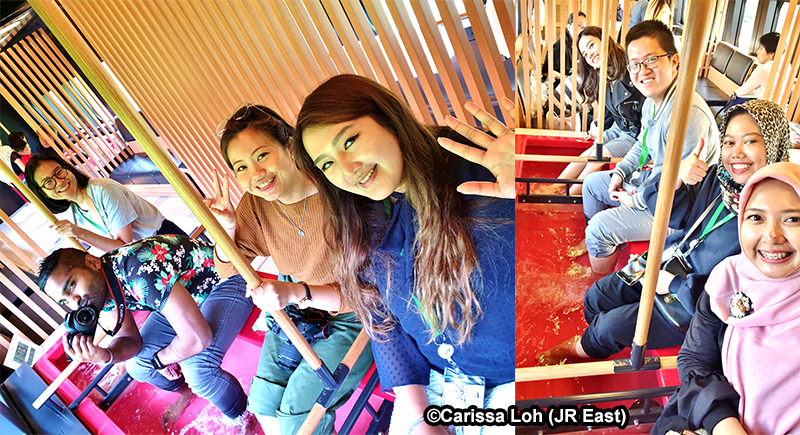
Enjoying a footbath! (Image credit: JR East / Carissa Loh)
For me and many other riders, the highlight of the Toreiyu Tsubasa is hands down the footbaths. It is like going for a mini spa session; relaxing while enjoying the scenery outside the window. With vibrant red tubs and wooden décor, this stylish footbath car is only open to the public before the train departs the starting station (Fukushima or Shinjo). Be sure to take your photos during this time. Once the train departs the starting station, only customers with reserved footbath sessions are permitted to enter the car.

Booking a footbath slot and exploring the footbath car. (Image credit: JR East / Carissa Loh)
So how does one get a coveted footbath slot? Footbath tickets can be purchased onboard from the bar counter on a first-come-first-served basis, at ¥450 per pax. There are TV screens in each car showing the availability of the slots, even in English for foreign visitors. Just send one representative from your group and let the counter staff know your preferred timeslot and how many people you are booking for.
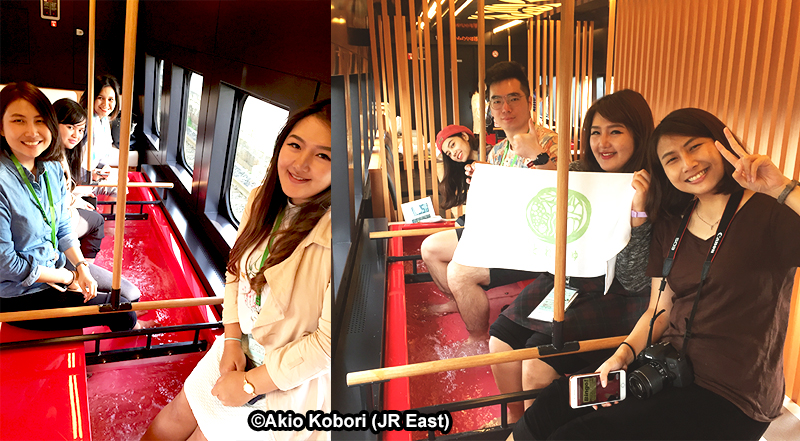
Enjoying a footbath again! (Image credit: JR East / Akio Kobori)
The footbath session lasts for 15 minutes, and each session can accommodate a maximum of eight people. There are two tubs, one facing each side of the train, and each tub can accommodate four people. Around 10 minutes before your scheduled session, you can enter the footbath car to get ready. Take a seat on the comfortable sofas, which are made with wood from the Tendo area. Take off your shoes and socks and put them in the bag provided. Once it is time, you can start soaking your feet. (Note: As a COVID-19 safe distancing measure, the footbath capacity will be reduced until further notice.)

Scenery from the footbath car (left) and souvenir towel (right). (Image credit: JR East / Carissa Loh)
Watch the scenic countryside views whiz by through the window as you enjoy the relaxing soak! The footbath ticket also includes a special Toreiyu Tsubasa towel and bag, provided as a souvenir for footbath users! Use the towel to dry your feet when you are done, and put it in the bag to bring home. Relaxing percussion music plays in the background, so it always feels like I am having a spa session! When time is almost up, the friendly staff will give a gentle reminder, and it’s time to wipe your feet and say goodbye before adjourning to the lounge car.
Relax in the lounge area
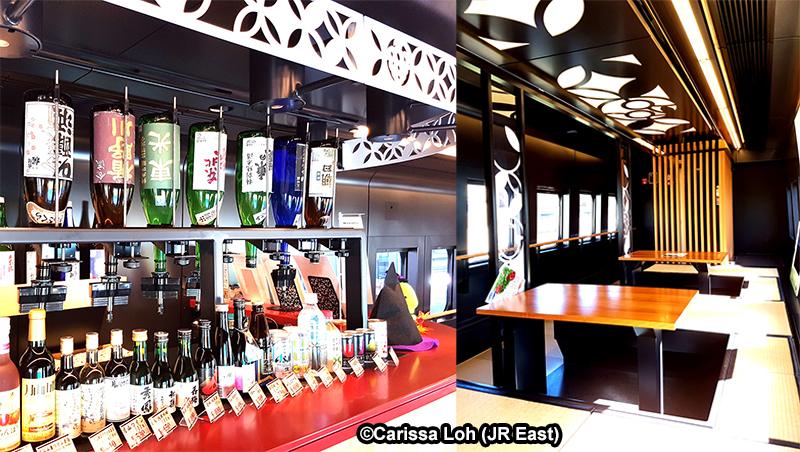
Toreiyu Tsubasa’s lounge car. (Image credit: JR East / Carissa Loh)
If you have ever been to an onsen in Japan, you might be familiar with the concept of yuagari dokoro (湯上り処), the practice of enjoying a cool drink to cool yourself down after taking a dip in the hot onsen water. The Toreiyu Tsubasa wants to bring this experience to you too, and thus built a Yuagari Lounge (湯上りラウンジ) car next to the footbath car, to mimic that experience by providing a casual and relaxed tatami seating area! The lounge features bar counter stocked with locally brewed Yamagata sake, fruit juice made from Yamagata-produced fruits, snacks and ice cream. As they are sold by the cup, sake lovers will enjoy sampling and comparing the sake bar’s different local varieties, but I highly recommend the fruit juices.
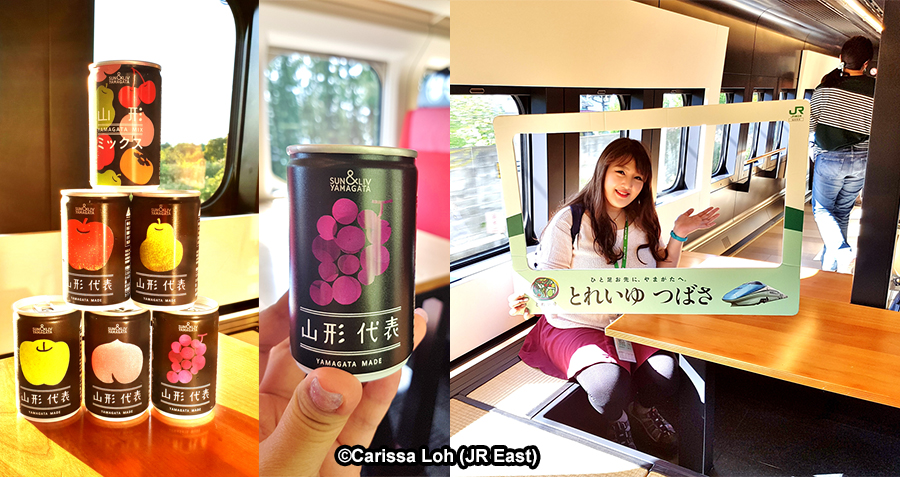
Relaxing after a footbath session. (Image credit: JR East / Carissa Loh)
At only ¥150 per can and with six flavours to choose from, these Made in Yamagata fruit juices are great drinks to enjoy after the footbath session. Yamagata produces top quality fruits, so don’t miss your chance to try them. I bought all six flavours to try, and my favorite is the grape! In the lounge there are also frame props to take photos and memories of your trip.
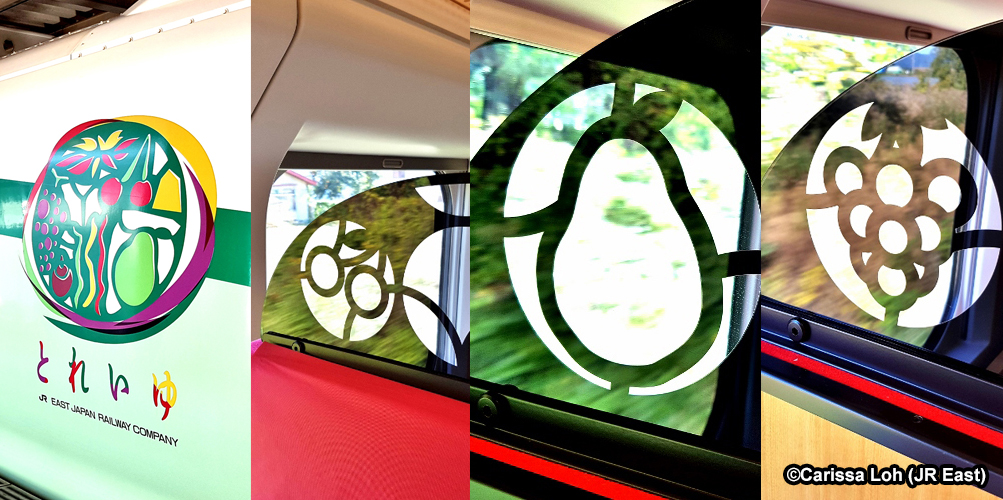
Fruit motifs on board the Toreiyu Tsubasa. (Image credit: JR East / Carissa Loh)
Other than being a hotspot for onsen, Yamagata is also known for its fruits (especially cherries), being one of the top producers of fruit in Japan. When you visit Yamagata, be sure to try some of their delicious fruit! Being a train trying to personify Yamagata, the Toreiyu Tsubasa has a colourful logo showing various fruits. If you look around the inside of the train closely, you can also spot fruit motifs inside—I spotted cherries, pears and grapes; there are different ones in each car.
Along the Yamagata Shinkansen Line, there are many wonderful sightseeing spots to explore, all close to the train station. Yamagata is surrounded by mountains on all sides, providing ideal conditions for growing fruit. There are also numerous onsen towns dotting the line. Here are my recommendations for some places you can visit when riding the Toreiyu Tsubasa:
Fruit-picking
- Cherries: From JR Sakurambohigashine Station (さくらんぼ東根駅), take a taxi ride to a nearby fruit farm.
- Grapes: From JR Akayu Station (赤湯駅) or JR Takahata Station (高畠駅), take a taxi ride to a nearby fruit farm.

Cherry-picking at Ohsyo Kajuen. (Image credit: JR East / Carissa Loh)
Surrounded by mountains on all sides, Yamagata is known as the “Kingdom of Fruits”, producing much of Japan’s fruits. It is most famous for its cherries, which can be picked in June to mid-July. Sweet La France pears can be picked in September to October, peaches in August to mid-September, and grapes from August to October.
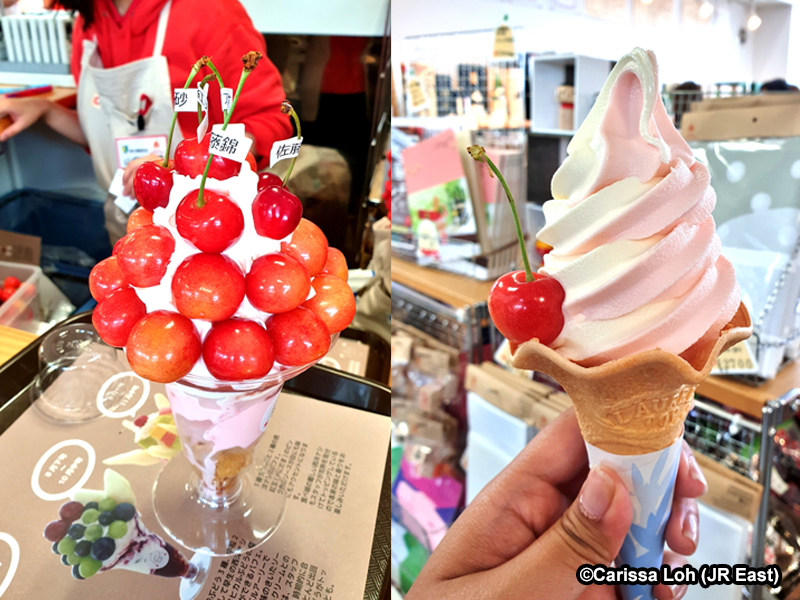
Cherry desserts at Ohsyo Kajuen. (Image credit: JR East / Carissa Loh)
Yamagata’s most well-known produce is its cherries (さくらんぼ sakuranbo), and the Higashine area is best known as a cherry-producing region. JR Sakurambohigashine Station, the bullet train station in Higashine, was so named to reflect the significance of cherries to this area! Did you know? Yamagata produces close to a whopping 70% of Japan’s cherries.
A popular cherry farm in the Higashine area is Ohsyo Kajuen Orchard (王将果樹園 Ōshō Kajuen), located a 20-minute drive from the station. You can make reservations for cherry-picking online here. It costs around ¥1,500 for 30 minutes of all-you-can-eat at the orchard. Pro-tip: Top-up a bit more to include a cherry soft serve ice cream or cherry parfait, they are delicious. In other months, the orchard also offers peach, grape and apple picking.

Grape-picking in mid-September. (Image credit: JR East / Carissa Loh)
The region around JR Akayu Station and JR Takahata Station has a lot of grape orchards and wineries. If you are a grape or wine lover, be sure to check them out. When I visited in mid-September, grape-picking was only ¥800 for unlimited picking and eating within the orchard. You must cut grapes by the bunch (not piece), so whatever you cannot finish, you must pay for to bring back. There are also packed grapes for sale. Since there is no time limit, just sit back, relax and enjoy your grapes until you are full.
Yamadera (山寺)
- From JR Yamagata Station (山形駅), transfer to the JR Senzan Line (仙山線) and take a 20-minute ride to JR Yamadera Station (山寺駅). Walk 5 minutes to the entrance.
The top of Yamadera. (Image credit: 山形県庁)
With a literal meaning of "mountain temple", Yamadera is a scenic temple in the mountains between Yamagata and Sendai. The top can be reached in approximately 1,000 steps spread over several steep stone staircases. The ascent takes about 30–60 minutes, depending on how often you stop to soak in the surrounding scenery and how many photo breaks you take. Reach the top and be rewarded with stunning panoramic views of the valley below.
Kaminoyama Onsen (かみのやま温泉) / Kaminoyama Castle (上山城)
- From JR Kaminoyamaonsen Station (かみのやま温泉駅), walk 10 minutes.
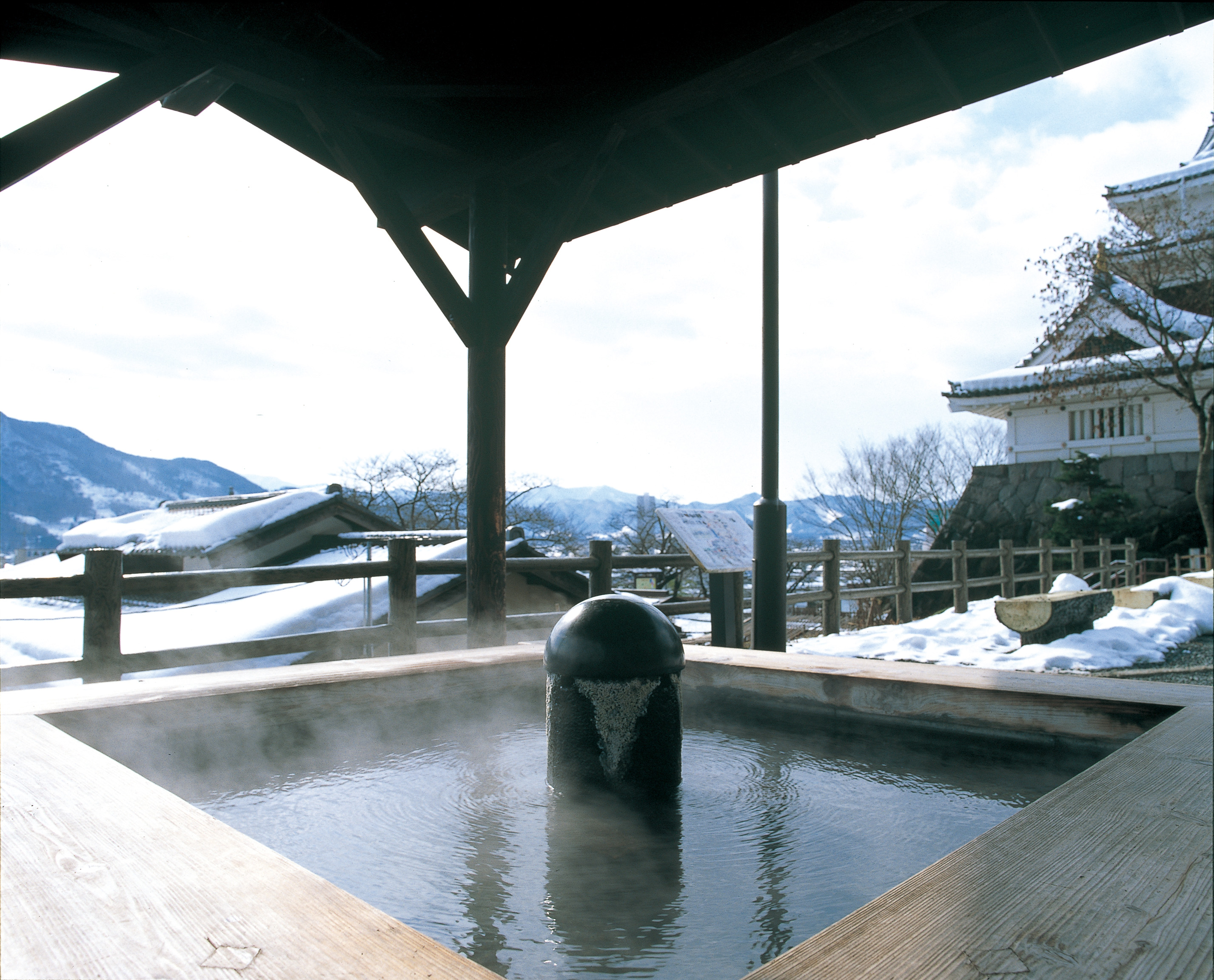
Footbath at Kaminoyama Castle. (Image credit: 山形県庁)
A popular cherry blossom viewing spot, Kaminoyama Castle is only 10 minutes by foot from JR Kaminoyamaonsen Station, situated in the middle of the onsen town. The castle grounds have free ashiyu, so you can soak your feet while enjoying the view of the cherry blossoms, or keep warm while enjoying the winter scenery. Nearby the onsen town, there is also a small street featuring four old samurai residences, one of which can be entered for a small fee.
Ginzan Onsen (銀山温泉)
- From JR О̄ishida Station (大石田駅), take a 40-minute bus ride to Ginzan Onsen.

Ginzan Onsen in winter. (Image credit: JR East / Carissa Loh)
Quickly gaining traction around the world for its magical atmosphere, Ginzan Onsen is exceptionally beautiful in winter, especially when snow falls in the evening. The dimly lit yellow gas lights shining in the night with falling snow is a wondrous sight reminiscent of a Studio Ghibli film. Used as a silver mine in the past, the name "Ginzan" means "Silver Mountain". It is now dotted with a dozen ryokan, drawing tourists all over the world for its rustic atmosphere.
Getting there
Running mostly on weekends and Japanese public holidays, the Toreiyu Tsubasa makes one round trip per day between JR Fukushima Station (福島駅) and JR Shinjō Station (新庄駅). Check out the timetable and schedule here.
The Toreiyu Tsubasa can be accessed from JR Fukushima Station, which is 80 minutes by bullet train from JR Tōkyō Station (東京駅). All seats on board this special train require reservations, which can be made here.
JR EAST PASS (Tohoku area)

The new JR EAST PASS (Tohoku area) and usage area. (Image credit: JR East)
If you are visiting the Tohoku region, check out the JR EAST PASS (Tohoku area), an affordable pass offering unlimited rail travel on JR East lines (including bullet trains!) in the valid area for 5 consecutive days at only ¥30,000. You can also make seat reservations for bullet trains, some limited express trains and Joyful Trains online for free, up to 1 month in advance, on the JR-EAST Train Reservation. The JR EAST PASS (Tohoku area) can be used for automatic ticket gates, and foreign passport holders living in Japan are also eligible to use this pass.

The JR-EAST Train Reservation. (Image credit: JR East)
The Toreiyu Tsubasa Joyful Train can also be ridden for free with the JR EAST PASS (Tohoku area). Without the pass, a trip from Fukushima to Yamagata on the Toreiyu Tsubasa costs about ¥3,450.
Header image credit: JR East / Carissa Loh




